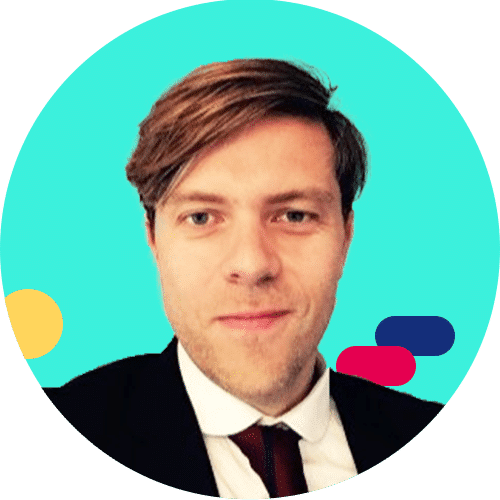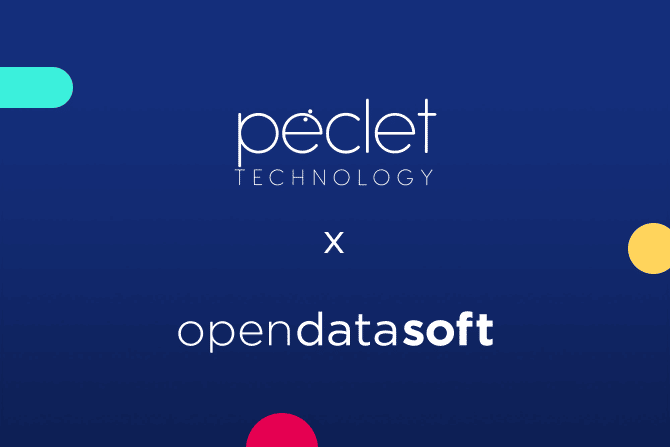Accelerating public sector data sharing – best practice from Australia
Data sharing enables public sector organizations to increase accountability, boost efficiency and meet changing stakeholder needs. Our blog shares use cases from Australia to inspire cities and municipalities around the world

When it comes to harnessing data within local government, cities and municipalities, there’s an enormous opportunity for organizations to learn from their peers, not just locally but globally. While every country has its own specific context, organizations across the world face similar challenges around meeting the changing needs of their citizens, increasing efficiency, boosting transparency, and building and protecting more engaged, inclusive and prosperous communities.
The experiences of local and city governments in Australia provides some great examples to inspire the public sector globally. Based on a recent meeting of local government open data teams, hosted by Opendatasoft partner Peclet Technology, this blog highlights key use cases where data sharing delivers real benefits to all.
Building a community around data sharing best practice
Peclet specializes in creating data portals and data experiences for local councils, state governments, and utilities. By combining expertise in graphic design, data science, and software development, Peclet makes data more understandable to help clients make better decisions and engage with their communities. It partnered with Opendatasoft in 2016, adopting its data portal solution to deliver data sharing for its customers.
Peclet is committed to explaining the benefits of data sharing to councils, businesses and wider society, and building a community of Local Councils which collaborates to highlight and share best practice. As part of this it organizes regular online open data group meetings, bringing together customers from across the country to discuss their latest projects.
Based on its most recent meeting, which is available to watch here, this blog outlines five examples of data sharing innovation from cities and local authorities that improve parking & transport, better protect citizens, adapt urban environments, and support economic development.
City of Melbourne - focusing on high impact use cases
The capital of the state of Victoria, Melbourne has over five million residents and is Australia’s second largest city. As an administration, the City of Melbourne is committed to openly sharing its data to drive engagement, innovation and efficiency. Given the volumes of data the city produces, it is focused on sharing high value datasets, based on what delivers a positive impact for citizens, businesses, and other stakeholders.
Helping drivers seamlessly find on-street parking
Surveys consistently rank parking as one of the public’s most-requested data, so Melbourne has released sensor data that covers 4,000 parking bays across the city. Not only does this show which spaces are free via the Melbourne data portal, but the information has been incorporated into a variety of apps and car navigation systems, providing drivers with a near real-time view to help them find somewhere to park, improving their experience and reducing congestion.

Delivering a new view of planning
Residents and businesses want to understand how Melbourne is being developed, and how plans for new buildings will shape the city’s future look. The open data team therefore created its Development Activity Model (DAM), which uses information from the city’s planning systems to provide a 3D representation of major development activity. People can see the current status of each development, and what the planned construction will be, as well as its relative height and size through the use of geo-polygons.
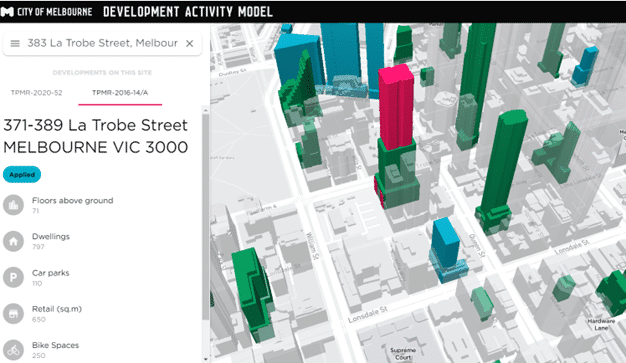
The benefits of data sharing in Melbourne
Every year over 52,000 people access the City of Melbourne’s open data portal, demonstrating its utility, impact, and usefulness for the community. It also creates value for the council itself, saving time and increasing innovation. For example, by making datasets available via self-service it has saved the city around 2,000 hours a year as it no longer needs to respond to the same number of Freedom of Information (FOI) requests. Data is also central to the council’s Open Innovation competition, enabling people and businesses to create new solutions based on the city’s information.
City of Newcastle - supporting businesses and investors
Located at the mouth of the Hunter river, the City of Newcastle in New South Wales has a population of over 174,000, and generates an estimated gross regional product (GRP) of AUS$ $21.06 billion. As part of its Economic Development strategy the city has a key objective of providing strategically useful information to existing and potential businesses and investors. It has therefore created its City Intelligence Program (CIP), an innovative curated and user-friendly digital platform built on council data assets around economic expenditure, current business types in a location and planning applications.
By sharing this data from across the council, businesses are able to make more informed decisions about where to locate or expand. For example, they can see expenditure data, broken down by area and day of the week and the composition of local businesses by sector and sub-sector, showing potential opportunities. All of this can be filtered and displayed on a 3D map, alongside current construction developments and planning applications. As this data is available through self-service, investors and businesses can shape their strategies while removing the need to contact the council, saving time and increasing efficiency. There’s more on the platform in this blog and video.

Greater Geelong - understanding mobility insights
The City of Greater Geelong is the second largest local government area in the state of Victoria and aims to be a leader in innovative and creative urban management. As part of this it has created the Geelong Data Exchange, a comprehensive data portal to share its data. This includes a range of insights on topics such as its urban forest, weather, land use and health, delivered through visualizations and dashboards.
Its latest insights dashboard covers mobility data, providing analysis of traffic and pedestrian flow and activity across the city. Collected through a network of sensors and cameras, with computer vision generated data, the dashboard provides a user-friendly, visual tool to show overall mobility in key points within the city, filterable by type, date and time of day.
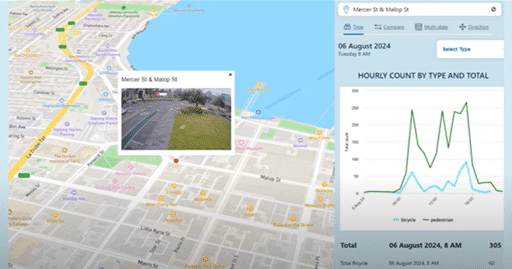
These insights are utilized both internally by transport planners, traffic engineers, event and open space teams and will be made available to the public going forward. This will support economic development, and attract investment and major events, while providing data for the media and FOI requests.
For example, Geelong is carrying out a major urban revitalization project to promote active transport through dedicated bike lanes. It is able to use the tool to monitor cycle traffic through the city at any time, such as when people are commuting to work, providing insights that can be used to shape future policies and infrastructure development. Equally the city’s events team is able to monitor the number of people at particular events, such as festivals, and use this to measure success, particularly when correlated with other information, such as spend data in local businesses.
Cumberland City Council - creating secure spaces for all
Ensuring that everyone feels safe within their community is a key role for local government. Cumberland City Council in New South Wales is showing how it is delivering on this need through an innovative data dashboard. Using funding from Transport for New South Wales it upgraded the physical infrastructure in one of the city’s laneways (narrow lanes), adding seating, CCTV, a play area, and a bright new color scheme.
To build community trust and encourage people to visit the upgraded space, it created an in-depth dashboard. This provides current information around the laneway, such as current and historic visitor usage and dwell time recorded via CCTV, weather data, and live local bus schedules. It also allows people to leave feedback on the upgrades and what they think of them.
As well as giving visitors live information, the dashboard brings together before and after data to demonstrate the impact that the investment has had. This includes comparative visitor and spend data, a word cloud showing how people described the laneway experience ahead of, and after, the changes, and a perception study with women and girls asking if they now felt safe there after dark. These are all delivered through understandable data stories. A particularly popular feature is a page with sliders that shows images of what the laneway looked like previously compared to now, enabling people to easily move between views. The result of the overall project has been a 5-6x increase in the number of visitors and greater spend in the area, all of which justifies the project and helps build a business case for future, similar initiatives.
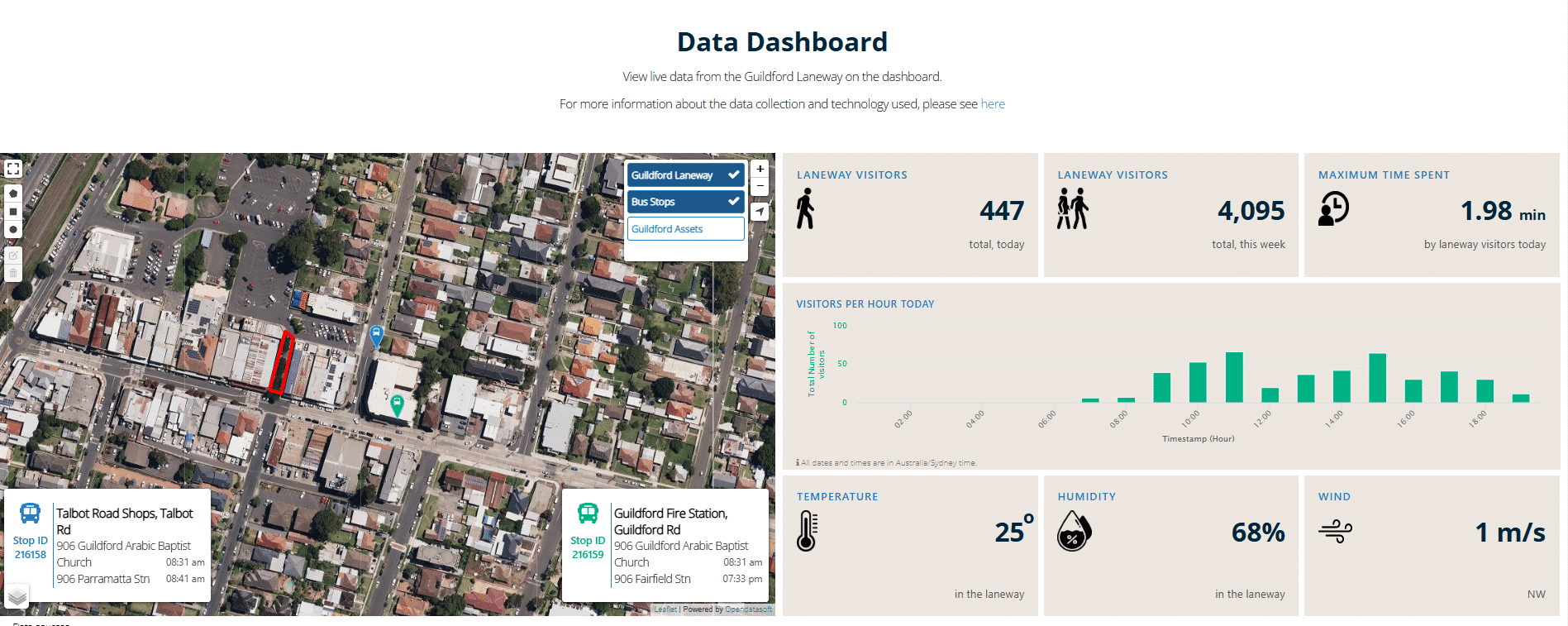
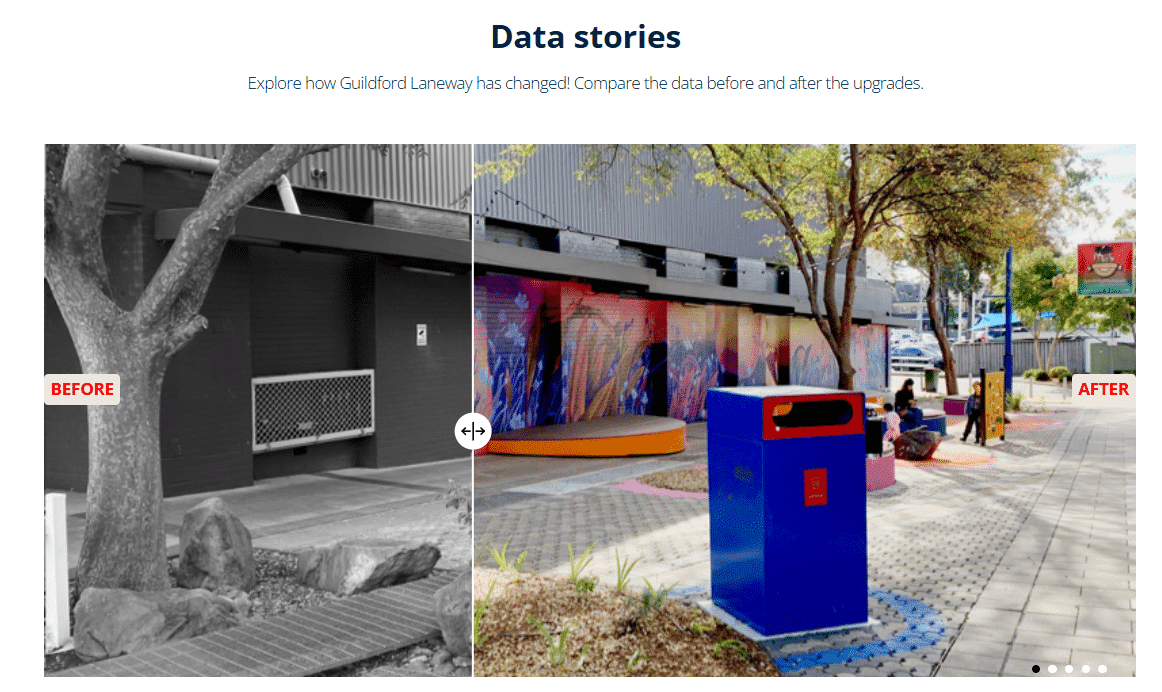
Wollondilly Shire Council - protecting from natural disasters
Situated on the southwestern edge of Sydney, Wollondilly Shire Council covers over 2,500 square kms. While it is currently home to just over 57,000 residents, this number is expected to grow to over 150,000 by 2041, making it one of the fastest growing local government authority in New South Wales. Protecting residents and property from natural disasters is complex due to the council’s large and varied area – some parts of Wollondilly are vulnerable to flooding and others to bushfires. To inform and help safeguard the community, the council is redeveloping its emergency dashboard as its existing solution was not delivering an intuitive or user-friendly experience either online or via the council’s e-kiosks which are situated in remote areas.
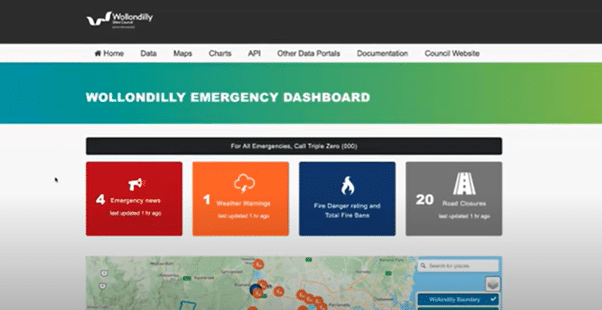
Working with its community and emergency agencies such as the police, the council has incorporated their feedback into the design of the new dashboard, which is expected to go live shortly. The aim is to create a one-stop shop for data that brings together information from multiple agencies and providers, delivering a single source of truth for users. As well as a map-based view of hazards and road closures, it includes emergency news from the Wollondilly Council website, weather warnings from the Bureau of Meteorology (BOM), power outages, traffic levels recorded via cameras, river heights, fire incidences, and the current fire danger warning level. Clear contact details, social media links and connections to local radio stations ensure users can keep in touch at all times.
Lessons from Australian data innovation
The sheer range and success of these use case examples demonstrates three key points around council data sharing:
- Data sharing has moved far beyond open data portals that provide transparency into council activities, and is now enabling innovative proactive applications in a variety of areas, and that deliver tangible ROI
- The user experience is vital – data has to be presented in ways that audiences can easily understand and benefit from, such as via dashboards and other visualizations
- Collaboration between different councils, wherever they are located, helps share innovation, spur new ideas and scale use cases to benefit everyone.
Work in local government and want to explore how data sharing can meet your changing needs? Book a personalized demo now to find out how we can help.
